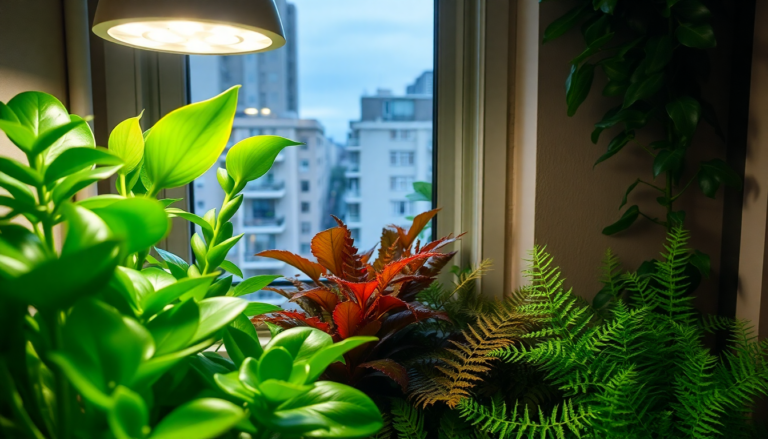Argomenti trattati
Imagine gazing at your indoor garden, lush and vibrant, even during the dreary winter months. Sounds dreamy, right? The secret to achieving this verdant paradise isn’t just about watering or the occasional spritz of plant food. Nope, it’s about giving your green friends the light they crave. If you’re like most of us, your home doesn’t resemble a sun-drenched greenhouse—especially if you live in an urban jungle. But fear not! Grow lights are here to save the day.
Understanding grow lights
So, what exactly is a grow light? Think of it as your plant’s personal sun, but in a bulb. These lights, particularly full-spectrum LEDs, mimic the natural sunlight that plants need for photosynthesis. Without the right light, even the hardiest plants can start to look a bit sad. As ecological landscape designer Kim Eierman puts it, most homes simply lack the adequate indoor lighting for plants to thrive. If your windows don’t bathe your leafy companions in a golden glow, grow lights can make all the difference.
Choosing the right grow light
When it comes to selecting a grow light, there are a few things to consider. First off, think about the types of plants you want to nurture. Some plants, like succulents and cacti, thrive under bright light, while others, such as ferns, prefer a softer glow. Weslie Etienne Pierre, a plant stylist and designer, mentions that certain plants, like dieffenbachias or monsteras, can really benefit from these lights. They can grow larger and develop more intricate leaves when given the right light conditions.
Next, consider the placement of your grow light. You may think putting it in a corner would suffice, but as Pierre wisely points out, the amount of light a plant receives is directly proportional to how much of the sky it can see. If your plant can’t see the window, it might not get the light it needs, which is where grow lights come in handy. They can be strategically placed to ensure your plants get the light they need without compromising your home’s aesthetic.
Types of grow lights
There’s a myriad of grow lights to choose from, so let’s break it down. Start with LEDs—they’re cooler than fluorescent lights and consume less energy. Plus, they produce more lumens per watt, making them a favorite among plant parents. You want to look for full-spectrum options, which provide a balance of blue and red light, essential for foliage growth and flowering. But, oh, the choices don’t stop there! You can opt for clip-on lights, which can be attached to pots, or more sophisticated setups that can accommodate multiple plants. I remember when I first tried a clip-on light for my rosemary plant. My apartment’s windows were less than ideal for sun-loving herbs, but with the added boost, I was able to cultivate fresh rosemary for my cooking!
Expert recommendations
To help you sift through the countless options, House Beautiful editors have tested several grow lights in their homes. They’ve found a few standouts. For instance, the SANSI grow bulb, with its sleek design, can fit into a variety of lamps without looking like a science experiment gone wrong. It casts a warm, inviting light that doesn’t disrupt your home’s ambiance, appealing to those who want to maintain a stylish look.
Then there’s the click-and-grow herb garden, which has a built-in grow light that operates automatically. I was amazed when I set it up; just plug it in, and voilà! It provided 16 hours of energy-efficient light daily without any fuss. Perfect for the forgetful gardener! And for those keen on starting from seeds, the grow light incubator can help you germinate up to 60 plants at once. I recall when my mother and I used one to grow cucumbers and spinach—seeing those first sprouts was pure joy.
Maximizing your indoor garden
Now that you’ve got your grow lights, how do you make the most of them? Start by understanding the wattage. Higher wattage means more powerful light, but also consider how long you keep it on. For instance, a 36-watt light might only need to be on for six to eight hours daily, while a lower wattage would require longer exposure. Keep an eye on your plants; they’ll let you know if they’re happy or not. If they’re stretching for the light, they might need more! And remember, not all plants have the same light requirements. For instance, microgreens love about 15 hours of light, while larger vegetables might need around 12 to 15 hours.
In my view, the key to a flourishing indoor garden is patience and observation. Plants are resilient, but they thrive best when their needs are met. And as any seasoned gardener will tell you, experimenting with different setups can lead to surprising results.
Conclusion thoughts
As we dive deeper into the world of indoor gardening, grow lights are proving to be essential companions for houseplant enthusiasts. Whether you’re trying to keep that pothos lush or coax a peace lily into bloom, the right light can transform your indoor space into a thriving oasis. So, don’t shy away from illuminating your green friends. After all, every plant deserves its shot at glory—one light bulb at a time!

